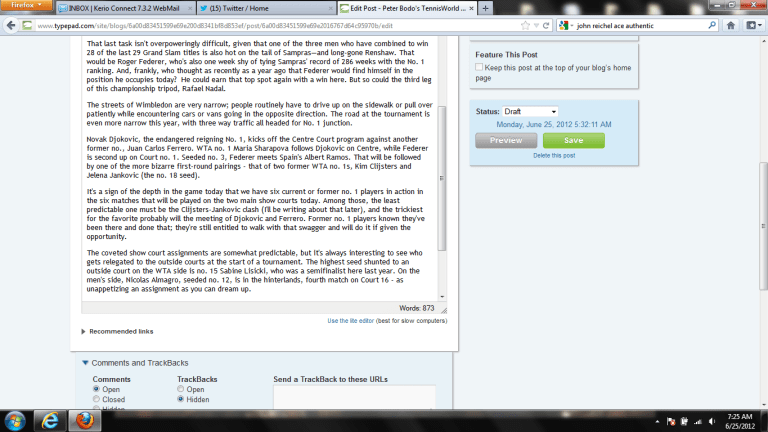* !Picby Pete Bodo*
WIMBLEDON, England—I can't think of a town or city so thoroughly dominated by a fleeting, two-week event as Wimbledon. Nor are many globally renowned athletic events known, simply, by the one-word name of the place or city where they take place (even Forest Hills, in the borough of Queens where the U.S. Open used to be played, was one word longer).
Wimbledon becomes hostage to tennis during this two-week period spanning the end of June and the beginning of July. Permanent residents flee, often for glamorous holidays underwritten by the hefty rents they collect from players and camp followers who rent their homes or flats for two or three weeks—or longer. Permanent signs direct pedestrians downhill to the All England Club, and even tell you where to go on the radio dial for Wimbledon traffic conditions.
As you walk down Church Road from Wimbledon village (passing St. Mary's church, where former Wimbledon champ Lew Hoad chose to get married, and which is a visible landmark from much of the AEC grounds) you pass Renshaw Place, named for William Renshaw, who won the seventh of his singles titles (a record he shares with Pete Sampras) in 1889. I've always meant to inquire about that large, white-washed home that sits just back off the street, surrounded by a brick wall, and appears to take up all there is of "Renshaw Place." Did Willie actually live there? Or did some tennis freak get carried away and, having bought the imposing home and surrounding quarter-acre, decide to give it a name honoring the man?
Whatever—it's just one of the countless signs, large and small, of how entwined the tournament is with the town. This morning, the yogurt shelf at the local Tesco's was already cleared out when I went shopping for breakfast; the culprit appeared to be a dirty-blonde girl who looked vaguely familiar. Dressed in tennis gear. Basket filled with yogurt and all kinds of athlete-friendly foods.
Well, here we are. The first day at a major is always daunting, the battlefield overwhelmed with smoke quickly into the proceedings, and someone in my shoes can get analysis paralysis trying to decide what to watch, where to go, (Centre Court for the star? An outside court for that quality so precious to every hack, atmosphere?), who to talk to, what is or isn't significant.
That last task isn't overpoweringly difficult, given that one of the three men who have combined to win 28 of the last 29 Grand Slam titles is also hot on the tail of Sampras—and long-gone Renshaw. That would be Roger Federer, who's also one week shy of tying Sampras' record of 286 weeks with the No. 1 ranking. And, frankly, who thought as recently as a year ago that Federer would find himself in the position he occupies today? He could earn that top spot again with a win here. But so could the third leg of this championship tripod, Rafael Nadal.
The streets of Wimbledon are very narrow; people routinely have to drive up on the sidewalk or pull over patiently while encountering cars or vans going in the opposite direction. The road at the tournament is even more narrow this year, with three way traffic all headed for No. 1 junction.
Novak Djokovic, the endangered reigning No. 1, kicks off the Centre Court program against another former No. 1, Juan Carlos Ferrero. WTA No. 1 Maria Sharapova follows Djokovic on Centre, while Federer is second up on Court No. 1. Seeded No. 3, Federer meets Spain's Albert Ramos. That will be followed by one of the more bizarre first-round pairings—that of two former WTA No. 1s, Kim Clijsters and Jelena Jankovic (the No. 18 seed).
It's a sign of the depth in the game today that we have six current or former No. 1 players in action in the six matches that will be played on the two main show courts today. Among those, the least predictable one must be the Clijsters-Jankovic clash (I'll be writing about that later), and the trickiest for the favorite probably will the meeting of Djokovic and Ferrero. Former No. 1s known that they've been there and done that; they're still entitled to walk with that swagger and will do it if given the opportunity.
The coveted show court assignments are somewhat predictable, but it's always interesting to see who gets relegated to the outside courts at the start of a tournament. The highest seed shunted to an outside court on the WTA side is No. 15 Sabine Lisicki, a semifinalist here last year. On the men's side, Nicolas Almagro, seeded No. 12, is in the hinterlands, fourth match on Court 16—as unappetizing an assignment as you can dream up. In fact, the tournament referee clearly doesn't think too highly of the vaunted Spanish "armada", as Juan Monaco (No. 15), Fernando Verdasco (No. 17) and Marcel Granollers (No. 24) are also out in the boondocks. Clay-courters. Bah!
Anyway, I think the toughest match of the day will be the first on Court No. 1, with David Nalbandian up against No. 8 seed Janko Tipsarevic. Nalbandian, a former finalist here, is a mercurial fellow (as that Queens Club linesman can well attest) and shotmaker. Tipsarevic will have his hands full.
Enjoy the tennis, everyone.
